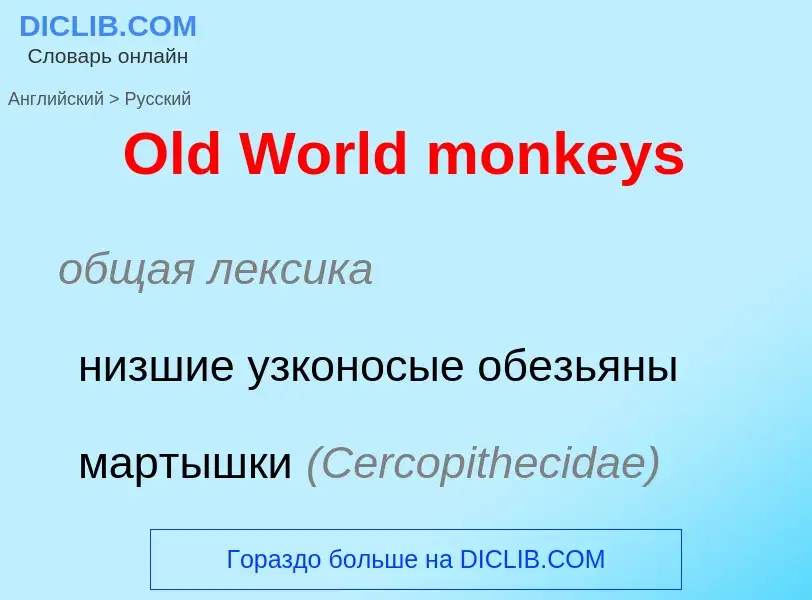Tradução e análise de palavras por inteligência artificial ChatGPT
Nesta página você pode obter uma análise detalhada de uma palavra ou frase, produzida usando a melhor tecnologia de inteligência artificial até o momento:
- como a palavra é usada
- frequência de uso
- é usado com mais frequência na fala oral ou escrita
- opções de tradução de palavras
- exemplos de uso (várias frases com tradução)
- etimologia
Old World monkeys - tradução para russo
общая лексика
низшие узконосые обезьяны
мартышки (Cercopithecidae)
['plætirain]
антропология
широконосый
медицина
плосконосый
прилагательное
антропология
широконосый
Definição
Wikipédia

Old World monkey is the common English name for a family of primates known taxonomically as the Cercopithecidae (). Twenty-four genera and 138 species are recognized, making it the largest primate family. Old World monkey genera include baboons (genus Papio), red colobus (genus Piliocolobus) and macaques (genus Macaca). Common names for other Old World monkeys include the talapoin, guenon, colobus, douc (douc langur, genus Pygathrix), vervet, gelada, mangabey (a group of genera), langur, mandrill, surili (Presbytis), patas, and proboscis monkey. Phylogenetically, they are more closely related to apes than to New World monkeys. They diverged from a common ancestor of New World monkeys around 45 to 55 million years ago.
The smallest Old World monkey is the talapoin, with a head and body 34–37 cm in length, and weighing between 0.7 and 1.3 kg. The largest is the male mandrill, around 70 cm in length, and weighing up to 50 kg. Old World monkeys have a variety of facial features; some have snouts, some are flat nosed, and many exhibit coloration. Most have tails, but they are not prehensile.
Old World monkeys are native to Africa and Asia today, inhabiting numerous environments: tropical rain forests, savannas, shrublands, and mountainous terrain. They inhabited much of Europe in the past; today, the only survivors in Europe are the Barbary macaques of Gibraltar. Whether they are native to Gibraltar or were brought by humans is unknown.
Some Old World monkeys are arboreal, such as the colobus monkeys; others are terrestrial, such as the baboons. Most are at least partially omnivorous, but all prefer plant matter, which forms the bulk of their diets. Most are highly opportunistic, primarily eating fruit, but also consuming almost any food items available, such as flowers, leaves, bulbs and rhizomes, insects, snails, small mammals, and garbage and handouts from humans.


![[[Nilgiri langur]] (''Trachypithecus johnii'') [[Nilgiri langur]] (''Trachypithecus johnii'')](https://commons.wikimedia.org/wiki/Special:FilePath/NILGIRI LANGUR (Trachypithecus johnii).jpg?width=200)
![A male [[rhesus macaque]] (''Macaca mulatta'') A male [[rhesus macaque]] (''Macaca mulatta'')](https://commons.wikimedia.org/wiki/Special:FilePath/Rhesus Macaque, Red Fort, Agra, India.jpg?width=200)
.jpg?width=200)
